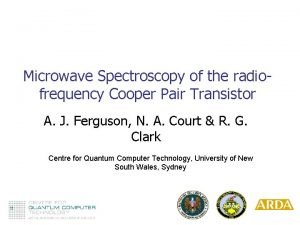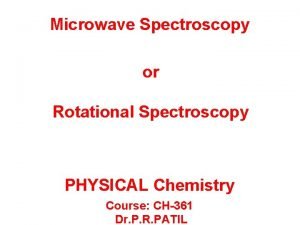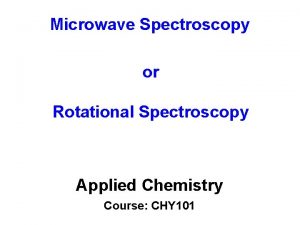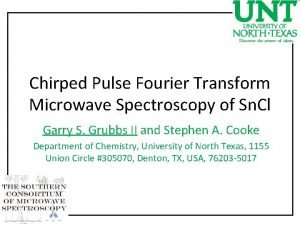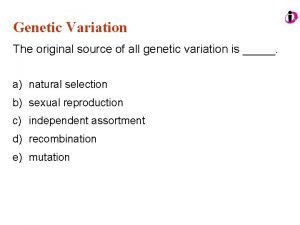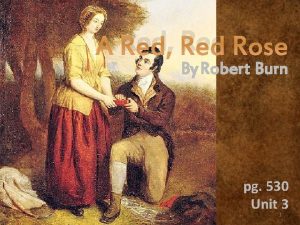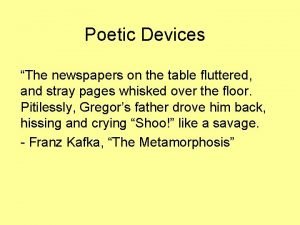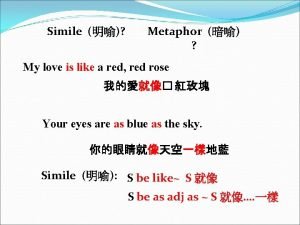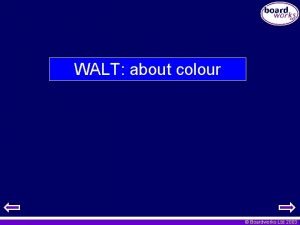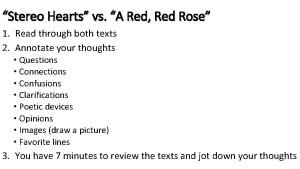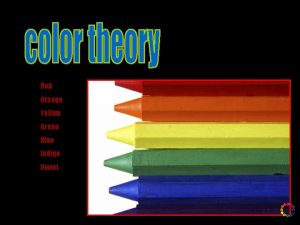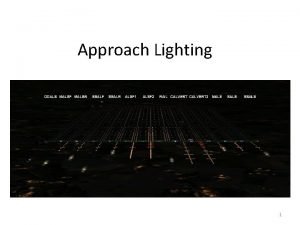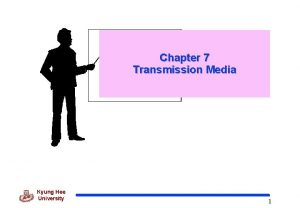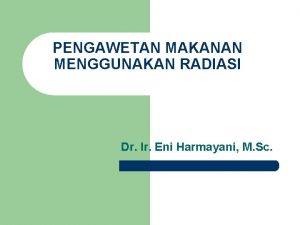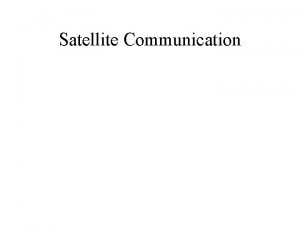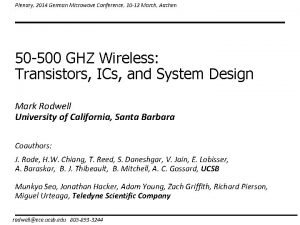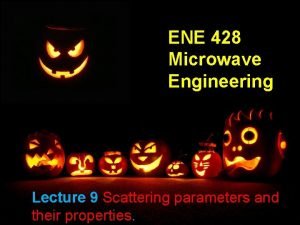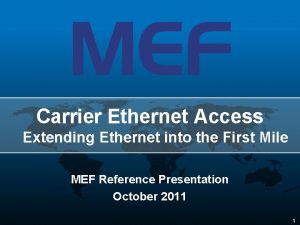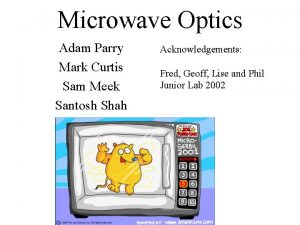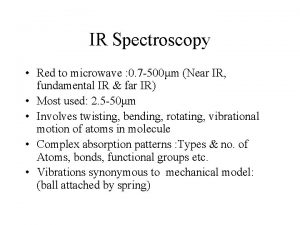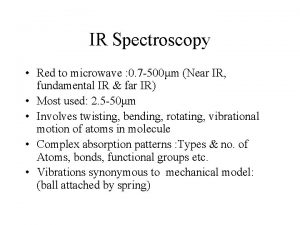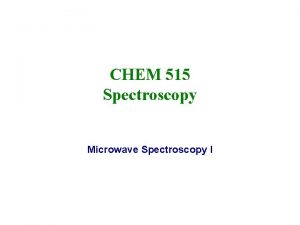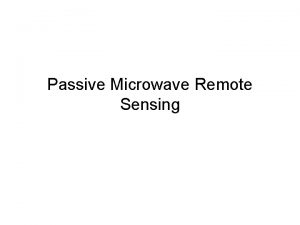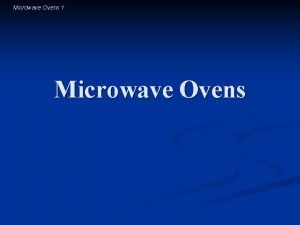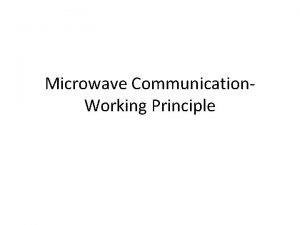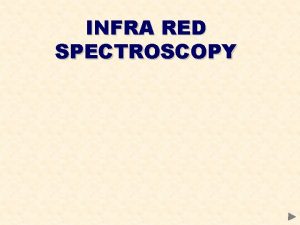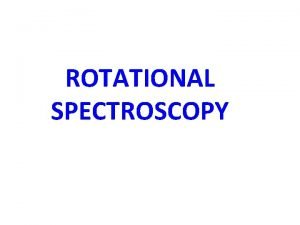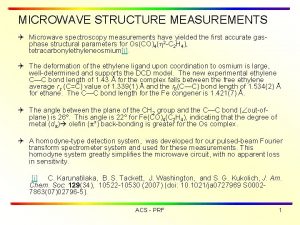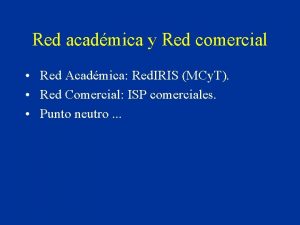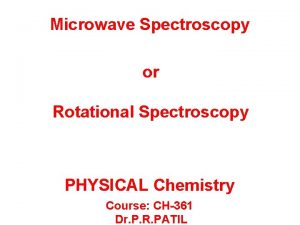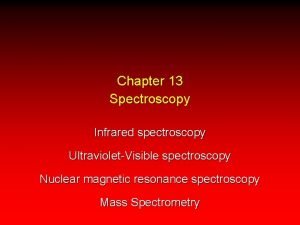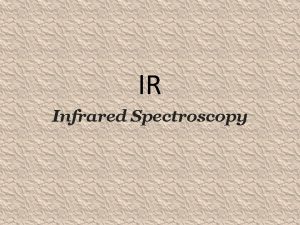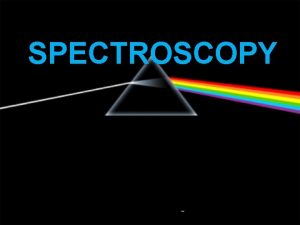IR Spectroscopy Red to microwave 0 7 500m























- Slides: 23

IR Spectroscopy • Red to microwave : 0. 7 -500μm (Near IR, fundamental IR & far IR) • Most used: 2. 5 -50μm • Involves twisting, bending, rotating, vibrational motion of atoms in molecule • Complex absorption patterns : Types & no. of Atoms, bonds, functional groups etc. • Vibrations synonymous to mechanical model: (ball attached by spring)

Molecular structure & IR Specta • IR spectrum : Superimposition of absorption bands of functional groups • Affected by molecular interactions • Absorption frequency (or its absence) correlates with bending stretching motion ( spatial relationship) • Information : Presence/absence of functional group • Discovery of new molecules

Near IR region • 0. 8 – 2. 5μm • Absorption bands H associated • eg O-H, N-H, C-H, Primary aromatic amines (stretch vibrations) • Determination of proteins, fats, sugar, oil moisture in other chemicals like glycerol, acetone etc. , etc. • Determination of substances in wood, components of polymers, geological exploration of aircrafts, etc

Mid IR region • • 2. 5 -15. 4μm Unsaturated states (double & triple bond) C=O, C=C, C=N N=O, S=O bonds Single bond stretching frequency &Bending vibrations : Molecular mass<19 • Identification of compound

• Far IR Region • 15 -1000μm • Bending vibrations of C, H, N, F with atom with mol. Mass>19 • Isomeric structures : sensitive to overall structure • Organometallic compounds: Coordination bonds

• Compound Identification • Available information : Physical state, Solubility, , melting point, flame test etc. • Pure or mixture • Organic or inorganic • Aromatic or Aliphatic • Functional group present or absent & frequency • Spectrum comparison

IR Instrumentation • (i) Dispersive (ii) Non dispersive • (i) Dispersive: Use prism or gratings: Ionic salts (KBr, Ca. F 2, Na. Cl, etc. ) • • Glass & quartz not transparent to IR Used for Qualitative analysis Choice dependent on wavelenght to be used Strong enough to be shaped and polished to make optical component • Problem: Water soluble (must be kept dessicated) • Alters opacity & light scatter

Dispersive cont… • Similar to UV dispersive spectrometers except different source and detectors used

Non Dispersive IR spectroscopy • Doest use prism or diffraction gratings not used for light dispersion • Use interference filters to isolate selected wavelength regions – Constructed of multiple layer of different material – Λ transmitted controlled by thickness & refractive index of central layer – Can be constructed for transmission of IR, Visible or UV region • Used for quantitative analysis • High Signal to noise ratio • Less complex/expensive, rugged, easy to maintain

Non Dispersive IR spectroscopy • Eg(i) Filter photometer (source: Nichrome wire, Transducer: Pyroelectric device, and interference filters)

Nonfilter photometer – Employ no wave length restricting device – Monitor gas stream

IR Radiation source • Ideal requirement – Continuous over wavelength used – Cover wide wavelength range – Constant over long time

IR Radiation source (cont…) • Near IR region: Tungsten filament lamp • Mid IR source (i) Wire source : Inert solid - Heated electrically to emit cont. radn (T=1100 C). - Eg Nichrome coil (forms light emitting oxide Reliable, simple, rugged inexpensive) - light source less intence

(ii)Nerst Glower: Brighter and hotter (1500 C) -Mde from fused mixture of rare earth oxides(Th, Zr, etc) – Fragile (iii)Globar source: Silicon carbide rod – Intermediate • Far IR region : High pressure Hg arcs

Detectors • (i) Thermal detectors: IR radiation produces heating affect altering physical property of detector – – – Maximizes temperature change to minimum IR level Element blackened and thermally insulated Usable over wide wave lengths (IR –visible) Operate at room temperature Disadvantage : Low response time and sensitivity Properties affected : Expansion (solid, fluid or gas), electrical resistance, voltage induced at junction & electric polarization

Thermal detectors- types • Thermocouple – Joining 2 dissimilar metals (Eg. Bismuth & Antimony) – Produce voltage α to temp. at junction • Thermophile – Several thermocouples connected in series – Convert radiant energy to electrical signal – Frequency response flat<35 Hz, response time 30 msec • Thermistor – Changes resistance when heated (5% per degree) – Made of fused mixture of metal oxides – Slow response time

• Bolometer – Change in conductance resistance to measure – Change in temperature depends on intensity of incident radiation • Pyroelectric detector: Uses Insulators, semiconductors or ferromagnetic material - Have crystal structure exhibiting magnetic field

Pyroelectric detector (Cont…) - Heating produces thermal alterations in crystal lattice spacing leading to electrical polarization - Effect depend on rate of change of detector temp - Fast response time - Choice for Fourier transform Spectrometer - Responds to changing radiation (ignores steady radn)

Photon detector • Relies on interaction between photon & semiconductors ( insulate when no radn. But conductors when radiation falls on it) • Radiation induces change in electrical resistance • Rapod respose and sensitive to IR • Exhibit cutoff towards far IR region • Used for FT spectrometer • Made of Lead selenide, Indole antimonide, etc.

Fourier Transform spectrometer • Intensity of light determined by simultaneously measuring all regions by array of detectors • Measures light at all wavelength to reconstruct intensity vs wavelength curve to give spectrum • Overlapping information sorted out by mathematical procedure called Fouriers transformed • Intensity vs wavelength expressed as sum of sine or cosine functions varying with time • Require data in digital form

Fourier Transform spectrometer • Source Monochromatic radiation beam splitter Fixed mirror Mobile mirror ( moves at contant velocity) Sample holder detector • Interference between beam for fixed and moving mirror • Constructive if in phase (max. if path diff. Is integral multiple of lamda) • Destructive if distance multiple of half of lamda No signal

Fourier Transform spectrometer • In between: Partial destructive interference • Signal reaches detector in cyclic pattern • Signal (Intensity vs pathlength) is a cosine finction called interferogram • Converted to IR plot of intensity vs wave length

Advantages of FT system • • Better signal/Noise ratio Fewer optical elements (lesser noise) Higher level of intensity reaching detector All measurements simultaneous (Time to collect data reduced) • Higher reproducibility and accuracy • S/N ratio is background corrected • More expensive due to precision of mirror movement
 What is microwave spectroscopy
What is microwave spectroscopy Rotational spectroscopy
Rotational spectroscopy Microwave inactive molecules
Microwave inactive molecules Chirped pulse fourier transform microwave spectroscopy
Chirped pulse fourier transform microwave spectroscopy Six-minute walk test 500m
Six-minute walk test 500m White over red pilot ahead
White over red pilot ahead The original source of all genetic variation is _____.
The original source of all genetic variation is _____. Red orange yellow white black
Red orange yellow white black A red red rose
A red red rose Poetic devices table
Poetic devices table Simile for red
Simile for red Why does a red ball look red
Why does a red ball look red Both artists use exaggeration to emphasize
Both artists use exaggeration to emphasize What color
What color Indigo and violet colors
Indigo and violet colors Rail runway lights
Rail runway lights Satellite microwave transmission
Satellite microwave transmission Eni harmayani
Eni harmayani Passive microwave repeater
Passive microwave repeater German microwave conference
German microwave conference Scattering matrix for a reciprocal network is
Scattering matrix for a reciprocal network is Microwave technologies for carrier ethernet services
Microwave technologies for carrier ethernet services Em wavelength spectrum
Em wavelength spectrum Sam meek
Sam meek
